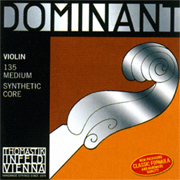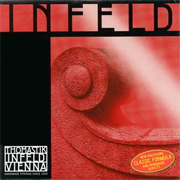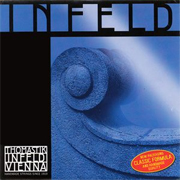Choosing a Violin
Choosing strings
What strings are the best?
There are many makers and brands of strings, but the biggest difference between them is the material.
Strings are made of a core that has a thin wire wound around it. Strings can be generally categorized by the material used for the core: steel, catgut, or nylon. Steel strings have a metal core, gut strings have a catgut core, and nylon has a core of nylon or some other man-made fiber. The thin wire used to wind around the core is often made of aluminum or silver, and most companies are developing new materials for both the core and winding.

Dominant strings
So, what is the best way to choose strings? The only way to choose strings is based on your preference for tone and feel. There are no hard rules to go by because even strings made of similar material will differ between brands. However, in general, steel strings are easier to keep in tune and are inexpensive, gut strings are difficult to keep in tune and are more expensive but have a richer tone, and nylon strings have a wide range of tonal qualities and prices.
Several of the major violin string brands are shown below for your reference. First is Dominant. Popular around the world, Dominant are the gold standard of violin strings. These are nylon strings, but the richness of expression is reminiscent of gut strings, and they are used by many professionals.

Infeld Red

Infeld Blue

Evah Pirazzi
Infeld is made by the producer of Dominant, and is similarly popular. There are two types, Red and Blue. Red has a heavier tonal quality, while Blue has a lighter tone. Some players use a mix of Red and Blue strings on a single instrument.
The strings made for advanced players are Evah Pirazzi. These strings are made from composites developed by the maker, and they have a powerful tone that is said to be suited to soloists.
Musical Instrument Guide : Violin Contents
Origins
Structure
How to Play
How the Instrument is Made
Choosing an Instrument
Care and Maintenance
Trivia
- The f-hole used to be a C-hole or S-hole
- Why the f-hole?
- Violinists must bow to the horse
- Steel strings or gut strings? That is the question
- Is the chinrest the unsung hero of the violin?
- Most violin varnishes are also medicines
- Violin masterpieces: Solos I
- Violin masterpieces: Solos II
- Violin masterpieces: Solos III
- Violin masterpieces: Concertos I
- Violin masterpieces: Concertos II
- Viola masterpieces: Chamber music
- Viola masterpieces: Concertos
- Cello masterpieces: Concertos I
- Cello masterpieces: Concertos II
- Cello masterpieces: Solos
- Contrabass masterpieces: Concertos
- Contrabass masterpieces: Chamber music
- Orchestral masterpieces featuring the contrabass
- What do you call the part on the bow that you hold?
